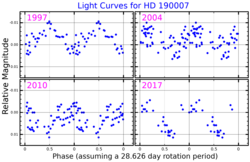HD 190007
| Observation data EpochJ2000EquinoxJ2000 | |
|---|---|
| Constellation | Aquila[2] |
| Right ascension | 20h02m47.04569s[3] |
| Declination | +03° 19′ 34.2658″[3] |
| Apparent magnitude(V) | 7.46[1] |
| Characteristics | |
| Evolutionary stage | main sequence[4] |
| Spectral type | K5 V[5] |
| U−Bcolor index | +1.09[6] |
| B−Vcolor index | +1.11[6] |
| Variable type | BY Dra[7] |
| Astrometry | |
| Radial velocity(Rv) | −30.268±0.0013[8]km/s |
| Proper motion(μ) | RA:−90.383mas/yr[3] Dec.:119.430mas/yr[3] |
| Parallax(π) | 78.6465 ± 0.0198mas[3] |
| Distance | 41.47 ± 0.01ly (12.715 ± 0.003pc) |
| Absolute magnitude(MV) | 6.91[2] |
| Details | |
| Mass | 0.77±0.02[1]M☉ |
| Radius | 0.80[9]R☉ |
| Luminosity | 0.24[9]L☉ |
| Surface gravity(logg) | 4.50[10]cgs |
| Temperature | 4,610±20[1]K |
| Metallicity[Fe/H] | 0.16[10]dex |
| Rotation | 28.626±0.046d[1] |
| Other designations | |
| Database references | |
| SIMBAD | data |
| ARICNS | data |
HD 190007,also known asGliese 775,is astarwith a close orbitingexoplanetin theconstellationofAquila.Parallaxmeasurements byGaiaput the star at a distance of 41.5light-years(12.7parsecs) away from the Sun. It is drifting closer with aradial velocityof −30.3 km/s,[8]and is predicted to come within 11.8 light-years in 375,000 years.[12]The star has anabsolute magnitudeof 6.91,[2]but at its present distance theapparent visual magnitudeis 7.46,[1]which is too faint to be viewed with the naked eye.
Thespectrumof HD 190007 matches aK-type main-sequence starwith astellar classificationof K5 V.[5]It is classified as aBY Draconis variable,showing a moderate level ofmagnetic activityin itschromosphere[4]with a suspectedactivity cyclelasting 13.7 years.[13]The star displays a mild enhancement ofmetalsand its age is uncertain. It has 77%[1]of the mass of the Sun, 80% of the Sun's radius,[9]and is spinning with arotation periodof 28.6 days.[1]HD 190007 is radiating 24%[9]of the luminosity of the Sun from itsphotosphereat aneffective temperatureof 4,610 K.[1]
Planetary system
[edit]The exoplanet HD 190007 b on a close orbit was first detected in 2020 by theradial-velocity method.[1]Between 2015 and 2019, theRoque de los Muchachos Observatoryin the Canary Islands observed HD 190007 to accumulate 37spectrographs.This, combined with 33 spectrographs from theW. M. Keck Observatoryin Hawaii over 6 years (1998 to 2014), flux measurements from theFairborn Observatoryin Arizona over 20 years, and a two-minute cadence with theTransiting Exoplanet Survey Satellitein 2022 provided the data to update the exoplanetary parameters by M. Stalport and associates in 2023.[4]
As theinclinationof theorbital planeis uncertain, only a lower bound on the exoplanet mass can be determined. It has at least 15.5 times the mass of theEarth.It is orbiting close to its parent star with a moderateeccentricityand aperiodof just 11.7 days.
| Companion (in order from star) |
Mass | Semimajor axis (AU) |
Orbital period (days) |
Eccentricity | Inclination | Radius |
|---|---|---|---|---|---|---|
| b | ≥15.5+1.2 −1.3M🜨 |
0.092±0.0008 | 11.724128(99) | 0.136+0.085 −0.080 |
— | — |
See also
[edit]- List of exoplanets discovered in 2023– HD 190007 b
References
[edit]- ^abcdefghijkBurt, Jennifer; et al. (2021)."A Collage of Small Planets from the Lick–Carnegie Exoplanet Survey: Exploring the Super-Earth and Sub-Neptune Mass Regime".The Astronomical Journal.161(1): 10.arXiv:2011.08867.Bibcode:2021AJ....161...10B.doi:10.3847/1538-3881/abc2d0.S2CID227013469.
- ^abcAnderson, E.; Francis, Ch. (2012). "XHIP: An extended hipparcos compilation".Astronomy Letters.38(5): 331.arXiv:1108.4971.Bibcode:2012AstL...38..331A.doi:10.1134/S1063773712050015.S2CID119257644.
- ^abcdVallenari, A.; et al. (Gaia collaboration) (2023)."GaiaData Release 3. Summary of the content and survey properties ".Astronomy and Astrophysics.674:A1.arXiv:2208.00211.Bibcode:2023A&A...674A...1G.doi:10.1051/0004-6361/202243940.S2CID244398875. Gaia DR3 record for this sourceatVizieR.
- ^abcdStalport, M.; et al. (August 2023). "A review of planetary systems around HD 99492, HD 147379 and HD 190007 with HARPS-N".Astronomy & Astrophysics.678:A90.arXiv:2308.05669.Bibcode:2023A&A...678A..90S.doi:10.1051/0004-6361/202346887.S2CID260775534.A90.
- ^abKirkpatrick, J. D.; et al. (1991)."A standard stellar spectral sequence in the red/near-infrared - Classes K5 to M9".Astrophysical Journal Supplement Series.77:417.Bibcode:1991ApJS...77..417K.doi:10.1086/191611.
- ^abJ.-C., Mermilliod (1986)."Compilation of Eggen's UBV data, transformed to UBV (unpublished)".Catalogue of Eggen's UBV Data.Bibcode:1986EgUBV........0M.
- ^Samus, N. N.; Durlevich, O. V.; et al. (2009). "VizieR Online Data Catalog: General Catalogue of Variable Stars (Samus+ 2007-2013)".VizieR On-line Data Catalog: B/GCVS. Originally Published in: 2009yCat....102025S.1:B/gcvs.Bibcode:2009yCat....102025S.
- ^abSoubiran, C.; et al. (2018). "Gaia Data Release 2. The catalogue of radial velocity standard stars".Astronomy and Astrophysics.616:A7.arXiv:1804.09370.Bibcode:2018A&A...616A...7S.doi:10.1051/0004-6361/201832795.S2CID52952408.
- ^abcdChandler, Colin Orion; et al. (2016)."The Catalog of Earth-Like Exoplanet Survey Targets (CELESTA): A Database of Habitable Zones Around Nearby Stars".The Astronomical Journal.151(3): 59.arXiv:1510.05666.Bibcode:2016AJ....151...59C.doi:10.3847/0004-6256/151/3/59.S2CID119246448.
- ^abMishenina, T. V.; et al. (2013). "Abundances of neutron-capture elements in stars of the Galactic disk substructures".Astronomy & Astrophysics.552:A128.arXiv:1303.1730.Bibcode:2013A&A...552A.128M.doi:10.1051/0004-6361/201220687.S2CID119268097.
- ^"HD 190007".SIMBAD.Centre de données astronomiques de Strasbourg.Retrieved4 September2017.
- ^Bailer-Jones, C.A.L.; et al. (2018). "New stellar encounters discovered in the second Gaia data release".Astronomy & Astrophysics.616:A37.arXiv:1805.07581.Bibcode:2018A&A...616A..37B.doi:10.1051/0004-6361/201833456.S2CID56269929.
- ^Obridko, V. N.; et al. (October 2022)."Solar and stellar activity cycles - no synchronization with exoplanets".Monthly Notices of the Royal Astronomical Society.516(1): 1251–1255.arXiv:2208.06190.Bibcode:2022MNRAS.516.1251O.doi:10.1093/mnras/stac2286.
External links
[edit]- Sol Station:http:// solstation /stars3/100-ks.htmArchived2017-12-24 at theWayback Machine

